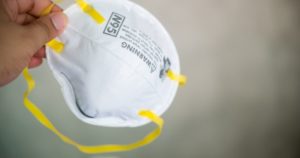Respiratory Protection Week: September 7-10
September 8, 2021 Just two years ago, the National Institute for Occupational Safety and Health (NIOSH) expanded N95 day into Respiratory Protection Week. The event aims to promote proper respiratory protection practices across workplaces and is being observed September 7-10. According to the Occupational Safety and Health Administration (OSHA), millions of American workers are required to wear respiratory protection to guard against various hazards in the workplace that can cause lung impairments, cancer, diseases, and death.
Just two years ago, the National Institute for Occupational Safety and Health (NIOSH) expanded N95 day into Respiratory Protection Week. The event aims to promote proper respiratory protection practices across workplaces and is being observed September 7-10. According to the Occupational Safety and Health Administration (OSHA), millions of American workers are required to wear respiratory protection to guard against various hazards in the workplace that can cause lung impairments, cancer, diseases, and death.
Some of the primary respiratory threats that workers can face on the job include:
- Sprays
- Gases
- Vapors
- Mists
- Smokes
- Harmful dusts
- Fogs
- Insufficient oxygen environments
Respiratory hazards are a major concern: without clean air, a person’s body cannot function properly. Respirators are devices that protect the wearer from inhaling hazardous atmospheres like the ones listed above. There are many different kinds of respirators, but they all protect the wearer in one of two ways. Certain respirators, like particulate respirators, protect the user by removing contaminants from the air. Other respirators, such as airline respirators, provide protection by supplying clean air from a separate oxygen source. Particulate and airline respirators protect workers from known hazards, and OSHA estimates that compliance with the agency’s Respiratory Protection Standard could prevent hundreds of deaths and thousands of illnesses each year.
OSHA standard requires respirators when engineering controls, like adequate ventilation or scrubbing the workplace for contaminants, do not sufficiently protect workers from respiratory hazards. Guarding workers against known respiratory hazards is critical; many lung diseases cause long-lasting effects and continue to cause problems even after exposure has ended. According to Johns Hopkins, certain workers face increased risks for inhaling harmful irritants, like factory, smokestack, exhaust, fire, mining, construction, and agricultural workers. Workers in textile factories and car garages face especially high risks for developing occupational lung diseases as well. Individuals can become ill with occupational lung diseases after a single exposure, repeated exposure or long-term exposure.
Johns Hopkins reports that some of the most common occupational lung diseases that workers develop are:
- Inhaling airborne crystalline silica causes silicosis, a condition that leads to lung scarring. Lung scarring increases the risk for other lung diseases and conditions. Individuals who work in mines, foundries, blasting operations, and stone, clay, and glass manufacturing facilities are at especially high risk for developing silicosis
- Coal worker’s pneumoconiosis, or black lung disease. Black lung disease can cause permanent damage and usually results from a person inhaling coal dust
- Hypersensitivity pneumonitis. There are different variations of this disease, such as farmer’s lung, cork worker’s lung, and mushroom worker’s lung. This disease is an allergic lung disease that happens after breathing in fungus spores, animal or plant protein, bacteria, or specific chemicals
- Occupational asthma, which is caused by breathing in dusts, fumes, and gases. It causes asthma symptoms, like wheezing and a chronic cough. Luckily, doctors can reverse occupational asthma if they find the condition early enough
- Asbestosis, which results from workers breathing in tiny asbestos fibers. Asbestosis causes lung scarring and stiff lung tissue
- Byssinosis, or brown lung disease. Textile workers face disproportionately high risks for developing byssinosis, which is a chronic condition that causes shortness of breath and chest tightness
Although different lung diseases cause different symptoms, there are some general warning signs. Potentially worrisome symptoms may include shortness of breath that worsens with activity, chest pain, chest tightness, coughing, and abnormal breathing patterns. Doctors may conduct an array of tests to diagnose an occupational lung disease in a patient, like a chest X-ray, a bronchoscopy, blood testing, lung biopsy, a pulmonary function test or PFT, or a CT or CAT scan.
Respiratory Protection Week affords us with an important reminder about how important it is to use proper respiratory protection, particularly in high-risk work environments. Employers are legally obligated to provide workers with a workplace free from recognizable hazards, which includes respiratory hazards. An employee should file a workers’ compensation claim if they experience an illness that occurs as a direct result of doing their job, like if they develop an occupational lung disease due to exposure. Workers’ compensation is a type of insurance that provides wage replacement and medical benefits to injured workers. If you sustained injuries while working and you would like to learn more about filing a workers’ compensation claim, someone at our firm can help. Contact a representative online now.
Philadelphia Workers’ Compensation Lawyers at Galfand Berger, LLP Representing Injured Victims Since 1947
Galfand Berger LLP has offices located in Philadelphia, Bethlehem, Reading and Lancaster, we serve clients throughout Pennsylvania and New Jersey. To schedule a consultation, call us at 800-222-8792 or complete our online contact form.
 Google Screened
Google Screened
